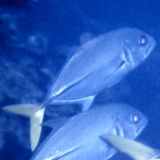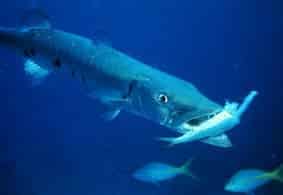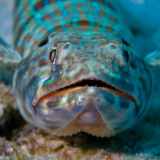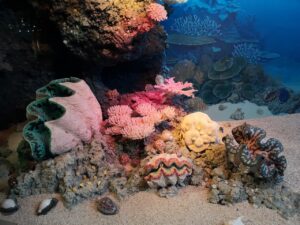Piscivorous Coral Reef Fishes
Animals whose primary food source is composed of fishes are termed piscivores. Piscivorous coral reef fishes are comparatively few in terms of both number of species and number of individuals.
Nonetheless, they are omnipresent in all coral reef habitats and no other feeding type found among reef fishes has so strongly influenced shaping both the bodies and habits of other coral reef fishes.

Hunting Stratigies
There are three different basic hunting strategies employed by piscivorous coral reef fishes, each requiring different physical adaptations and behaviors. These may be looely defined as pursuit, stalking, and ambush. Here, we shall take a closer look at all three of these tactics and the special adaptations required for each.
Pursuing Predators
Pursuing piscivores are those that rely on sheer speed to run down prey in open water. They are capable of sustained high speed swimming, and bursts of extremely fast attack speeds.
These types of predators are generally characterized by streamlined torpedo-shaped bodies that offer low frictional resistance (drag) to movement through water.
Most also have a distinctive sickle-shaped tail shaped caudal (tail) fin and very narrow caudal peduncle (the body area just forward of the tail fin) equipped with lateral keel-like projections (see photo, above).
Examples of common pursuing piscivorous coral reef fishes are the jacks (Carangidae), mackerels (Scombridae), and many sharks. Such predators generally initiate their attack from a moving start at considerable range, perhaps where visual detection of prey is first possible.

Stalking Predators
Stalking piscivorous coral reef fishes are capable of swift bursts of speed, but unlike pursuing predators these fish hunters utilize stealth and camouflage to enable them to initiate attacks at fairly close range; often no more than a few body lengths.
These types of predators typically have slender, elongated bodies that present a minimal profile to the prey when seen head-on, the normal stalking position of these hunters just prior to attack.
They also have a distinctive fin configuration composed of symmetrical posterior fins that function much like the vanes of an arrow, ensuring an accurate strike. In addition, they posses oversized caudal fins that allow them to accelerate quickly from a hovering position.
Common examples of stalking piscivorous fishes common in coral reef ecosystems include the barracudas (Sphyraenidae), trumpetfishes (Aulostomidae), and needlefishes (Belonidae).

Ambush Predators
Ambush predators rely on disguise and stillness to hunt other fishes. Most of the ambush-style piscivorous coral reef fishes are anything but sleek or swift swimmers. Rather, they use color patterns or background matching to make them virtually invisible as they wait motionless for unsuspecting victims to wander within striking range.
In these sly hunters, attacks are generally made at very close range, often less than a body length. Most have very large upturned mouths that enable them to inhale their luckless victims in a single swift gulp.
Common examples of ambush piscivores of coral reef ecosystems include the frogfishes (Antennariidae, pictured left), lizardfishes (Synodontidae), and scorpionfishes (Scorpaenidae).
Many of the groupers and seabasses (Serranidae) are masters of the ambush attack, waiting patiently in caves at the base of the reef.
Some groupers also hunt as stalking predators at times, using their color patterns and huge tail fins to allow a quick strike from close range.
Ambush predators are not confined to the reef proper; some types utilize other ecosystem habitat types. The best example of such “bushwackers” are the flatfishes such as flounders, which lie in wait under a thin layer of sand with only the eyes protruding.

The Twilight Advantage
Some pursuing and stalking coral reef piscivores have become particularly adept at hunting around the hours of sunrise and sunset, and this is when they are most active.
The primary underlying reason for this strategy can be found in the comparative visual abilities of such predators and their prey. Not surprisingly, coral reef fishes active by day have eyes that have evolved to function best under the relatively bright light normal during this period. Conversely, night active reef fishes have eyes best suited for very low light levels.
But some piscivorous coral reef fishes have evolved eyes that work better than either day-active or night-active fishes during two brief (30-45 minute) periods each day when it is neither bright nor dark; the hours of sunrise and sunset.
At these times such predators take up hunting positions close to the sea floor, where they wait – invisible to their prey – until they spot a careless victim silhouetted in the faded light against the sea surface.
Join Our Mailing list
Get updates via email on all things coral.



